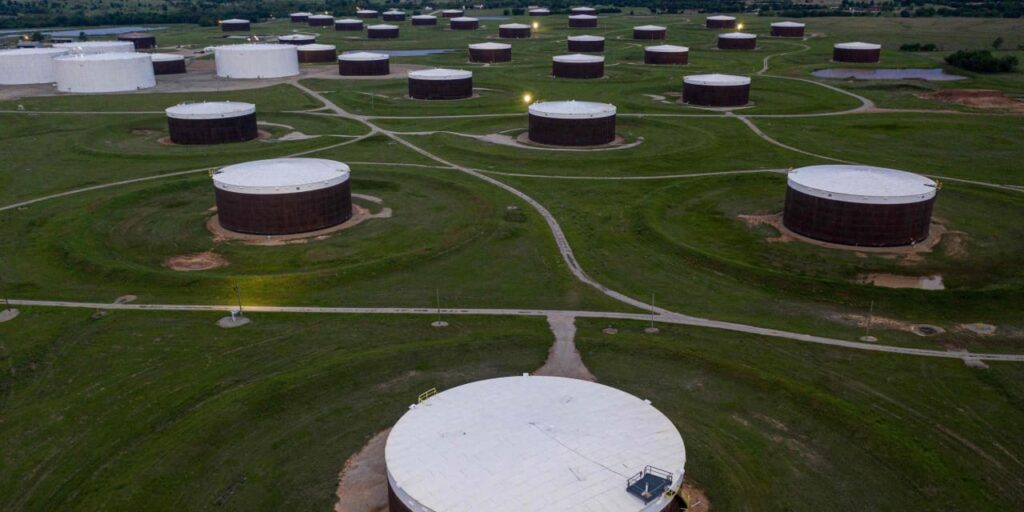Oil futures settled lower Thursday, pressured after official U.S. data showed what at least one analyst referred to as a “massive” weekly rise in domestic gasoline and distillate supplies. Prices shook off their earlier support from the shutdown of Libya’s largest oil field and rising tensions around the Israel-Hamas war.
Price action
-
West Texas Intermediate crude for February delivery
CL00,
+3.01% CL.1,
+3.01% CLG24,
+3.01%
fell 51 cents, or 0.7%, to settle at $72.19 a barrel on the New York Mercantile Exchange. -
Brent crude for March delivery
BRN00,
+2.93% BRNH24,
+2.93% ,
the global benchmark, lost 66 cents, or 0.8%, at $77.59 a barrel on ICE Futures Europe. -
February gasoline
RBG24,
+2.80%
declined by 2.2% to $2.11 a gallon, while February heating oil
HOG24,
+2.87%
fell 0.6% to $2.59 a gallon. -
Natural gas for February delivery
NGG24,
+3.04%
settled at $2.82 per million British thermal units, up 5.7%.
Supply data
Crude prices ended lower Thursday as official U.S. data showed sharp weekly gains in petroleum-product supplies, raising concerns about fuel demand.
Supply data from the Energy Information Administration, which came out a day later than usual due to Monday’s New Year’s Day holiday, revealed that U.S. commercial-crude inventories fell by 5.5 million barrels for the week ending Dec. 29.
On average, analysts surveyed by S&P Global Commodity Insights expected to see a weekly decline of 4 million barrels. The American Petroleum Institute, an industry trade group, reported late Wednesday that crude inventories fell by 7.4 million barrels last week, according to a source citing the data.
The EIA’s reported rise in petroleum-product inventories, however, was deemed “massive” by Anas Alhajji, managing partner at Energy Outlook Advisors.
Gasoline inventories climbed by 10.9 million barrels, while distillate stockpiles were up by 10.1 million barrels last week, the EIA said.
On average, analysts surveyed by S&P Global Commodity Insights expected the EIA to report gasoline inventories up by 2.3 million barrels and distillates up by 2.6 million barrels.
The EIA reported that finished motor gasoline supplied, a proxy for demand, stood at 7.954 million barrels a day for the week ended Dec. 29, down from 9.168 million barrels a day a week earlier. Distillate fuel supplied also fell to 2.658 million bpd, from 3.977 million bpd.
Gasoline and distillate fuel supplied, which is typically viewed as an implied measure of consumer demand, “fell off a cliff,” Tyler Richey, co-editor of Sevens Report Research, told MarketWatch.
“Gasoline and distillate fuel supplied, which is typically viewed as an implied measure of consumer demand, “fell off a cliff.””
The roughly 20 million-barrel surge in refined-product stockpiles was “largely the function of the massive drop-off in deliveries around Christmas and New Year’s, which is notably typical in late December and early January,” Richey said.
Also on Thursday, the EIA separately reported that U.S. natural-gas supplies in storage fell by 14 billion cubic feet for the week ended Dec. 29.
That was smaller than the average decline of 50 billion cubic feet forecast by analysts surveyed by S&P Global Commodity Insights.
Other market drivers
Oil had gotten a lift in early Thursday dealings as protests shut down Libya’s Sharara oil field, which produces 300,000 barrels a day of crude.
Fears of a broader conflict in the Middle East were on the rise after blasts in Iran killed 95 people and injured more than 200 at a ceremony marking the anniversary of the death of senior Islamic Revolutionary Guard Corps officer Qasem Soleimani, who was killed by a U.S. airstrike in 2020. The Islamic State reportedly claimed responsibility for the explosions on Thursday.
The attack comes against the backdrop of the Israel-Hamas war and fears of a wider conflict that could curtail crude supplies from the Middle East. Major shipping companies have suspended cargo shipments through the Red Sea following a series of drone and missile attacks by Iran-backed Houthi rebels in Yemen since the start of the war.
See: Red Sea crisis highlights ‘clear and present danger’ of wider war involving Iran
Against this backdrop, the Organization of the Petroleum Exporting Countries and its allies, together known as OPEC+, reaffirmed in a statement released Wednesday the “full commitment” by the countries participating in its Declaration of Cooperation to “unity and cohesion, as well as their continued and unwavering efforts to maintain oil-market stability going forward.”
“This is a cold and calculated move that is designed to regain control of the global oil markets by controlling all the world’s spare oil capacity at a time when the risk to global supply is higher than it has been in at least 50 years,” Phil Flynn, senior market analyst at The Price Futures Group, said in a daily report.
—The Associated Press contributed.
Read the full article here



